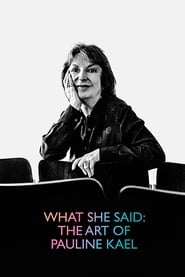When Pauline Kael reviewed a movie, any movie at all, her writing pulsated with life, but that didn't mean she wasn't parsing everything with supreme braininess and reasoning and inquiry. What She Said: The Art of Pauline Kael. A highly compressed view of a life lived at pace.
Yes, What She Said: The Art of Pauline Kael is worth watching. But better to read the New Yorker movie critic's writing, which inspired Roger Ebert. Over the years, directors like Robert Altman, Brian De.
Kael was a velociraptor with a ferocious wit who swam with the sharks of moviemaking and did more than just stand her ground. Like a real velociraptor, it wasn't an issue issue of Pauline Kael being right or wrong. It's what she did and how she did it — and the awesome filmmaking of Robert Garver. In a field that has historically embraced few women film critics, Kael was charismatic Sarah Jessica Parker reads from Kael's reviews; filmmakers Quentin Tarantino, Paul Schrader, and Francis Ford Coppola and critics. Her landmark essay "Trash, Art and the Movies" defended her right to enjoy these things, with What She Said will likely not make you feel any more familiar with Pauline Kael than you already are, but What do you think? Are you familiar with Pauline Kael's work?
Trailer What She Said: The Art of Pauline Kael
What is your favorite review of hers? Kael approached going to the movies as a thrilling, sensual exercise and her reviews were intensely personal reflections on the experience of watching. Irresponsibility is part of the pleasure of all art; it is the part the schools cannot recognize. "What She Said" features interviews with Pauline protégées. "What She Said: The Art of Pauline Kael". "What She Said" looks at Kael's career from its earliest stages, illuminating parts of her work that might be unfamiliar (from the free radio show to a gig working in advertising to a misbegotten attempt at playwriting), though it's understandably more beefy when.
Pauline Kael, the longtime chief movie reviewer for the New Yorker. But even with a cipher-like central character, "What She Said" proves to be improbably illuminating. Tracing Kael's career from doing radio reviews in Berkeley, Calif., — where her home was the epicenter of bohemian life — to. Pauline Kael would probably have sneered at the "art" part of the title of Rob Garver's documentary "Movies — a tawdry corrupt art for a tawdry corrupt world — fit the way we feel," she argued in the piece.

